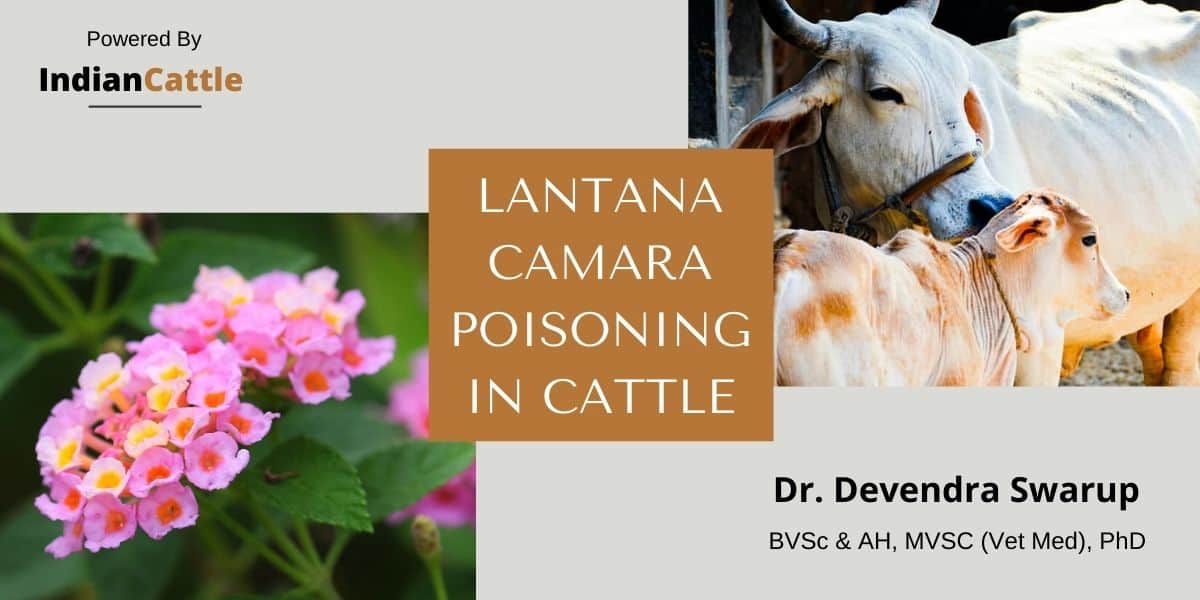
Poison Toxin: Lantana Camara Poisoning in Cattle
Source: Toxin lantadene present in Lantana (banphul, panchphuli), a noxious weed distributed widely in tropical and subtropical regions.
Specific symptoms: Anorexia, photosensitisation, jaundice marked by yellowing of sclera and mucus membranes, yellow urine, photosensitive dermatitis (Five in order of primacy).
Complicated symptoms: Severe depression, ruminal stasis, constipation followed by diarrhea, skin necrosis and sloughing, dehydration (Five in order of primacy).
Necropsy lesions: Marked icterus, hydrothorax, ascites, yellowish brown to orange colored swollen liver, bilateral per-renal edema.
Samples for laboratory examination: Whole blood (EDTA), serum, formalin fixed liver, kidney and gastrointestinal tract tissues, rumen content (frozen 100g).
Laboratory diagnosis (parameters): Serum bilirubin, liver-specific enzymes (GGT, SDH, AST, ALT), serum protein profile, blood urea nitrogen, CBC.
Specific Treatment:
- Generic name of the drug: Activated charcoal (AC)
Dose rate: 1-5 mg/ Kg BW. Slurry prepared in water (~ 1 g AC+ 5 ml water ) to be given orally
Contraindication/ Precautions/ Drug interaction: Should not be used with mineral oils and electrolyte solutions as these can reduce adsorptive capacity of AC. A gap of at least 3 hrs to be observed for giving any other therapeutic agent after AC dose
Side effects: Aspiration pneumonia may occur due to faulty administration of AC. Some animals may show constipation and diarrhea
- Generic name of the drug: Magnesium sulphate
Dose rates: 200-500 mg/kg BW orally mixed in the AC slurry
Contraindication/ Precautions/ Drug interaction: Should not be used in animals having diarrhea
Side effects: Not reported
Supportive treatment:
- Generic name of the drug: Chlorpheniramine maleate
Dose rates: 10-15 ml IM for 3-5 days
Contraindication/ Precautions/ Drug interaction: Contraindicated in hyperthyroidism cases
Side effects: Transient lethargy, somnolence and anorexia
- Generic name of the drug: Dextrose (50%) parenteral solution
Dose rates: 1-4 ml/kg bw (0.1-0.2 g /kg bw / hr) IV SOS
Contraindication/ Precautions/ Drug interaction: Contraindicated in hyperglycemic patients
Side effects: Continuous administration in higher dose (0.3 g/ kg/hr) may induce hyperglycemia, hypophosphatemia. Intravenous dextrose infusion causes transient decrease in plasma potassium concentration, decreased dry matter intake and a transient increase followed by a sustained decrease in milk production in lactating cows
- Generic name of the drug: Vitamin B 12 Complex
Dose rates: 1000- 2000 mcg IM on alternate day X 5 (commercial preparations containing thiamine HCL, riboflavin, niacinamide, vitamin B12 and crude liver extract are used @10 ml IM on alternate days )
Contraindication/ Precautions/ Drug interaction: Not reported in farm animal
Side effects: Not reported in fram animals
Contraindication: Should not be used together with CNS depressants and other interactive drugs
Side effects: Occasionally contradictory signs of CNS stimulation
Any Other recommendation/ comment:
- Immediately remove all animals from source of poisoning and those affected from sunlight
- Choice of fluid therapy depends on clinical assessment of the patients. Isotonic saline solution @2-5 ml/ kg IV and Ringer’s lactated solutions @1-4 ml/kg bw have also been used effectively for management of fluid loss in poisoned animals
- Suitable Topical preparations containing essential fatty acids/antiseptic can be used to treat skin lesions
- Depending on the clinical status of the animals, antibiotics/NSAIDs/ corticosteroids can be administered parenterally and adequate doses maintained. In severe cases antibiotics should be used as prophylactic therapy to avoid septicaemia
- Rumenotomy may be performed to remove ingested lantana plant
Dr. Devendra Swarup
BVSc & AH, MVSC (Vet Med), PhD
Former Director, ICAR-CIRG and Head Division of Medicine, ICAR- IVRI
